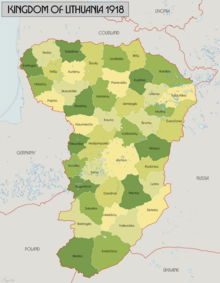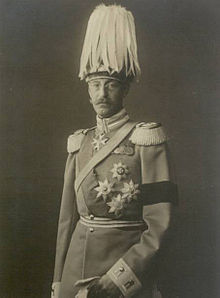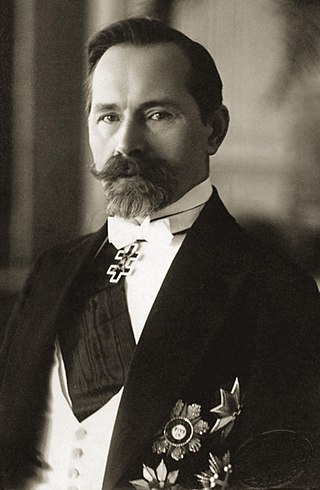
Antanas Smetona was a Lithuanian intellectual, journalist and politician who served as the first president of Lithuania from 1919 to 1920 and again from 1926 until the Soviet occupation of Lithuania in 1940. Referred to as the "Leader of the Nation" during his presidency, Smetona is recognised as one of the most important Lithuanian political figures between World War I and World War II, and a prominent ideologists of Lithuanian nationalism and the movement for national revival.

Aleksandras Stulginskis was the second President of Lithuania (1920–1926). Stulginskis was also acting President of Lithuania for a few hours later in 1926, following a military coup that was led by his predecessor, President Antanas Smetona, and which had brought down Stulginskis's successor, Kazys Grinius. The coup returned Smetona to office after Stulginskis's brief formal assumption of the Presidency.

The Polish–Lithuanian War was an undeclared war between newly independent Lithuania and Poland following World War I, which happened mainly in the Vilnius and Suwałki regions. The war is viewed differently by the respective sides. According to Lithuanian historians, it was part of the Lithuanian Wars of Independence and lasted from May 1919 to 29 November 1920. Polish historians deem the Polish–Lithuanian war as occurring only in September–October 1920. Since the spring of 1920, the conflict became part of the wider Polish–Soviet War and was largely shaped by its progress. It was subject to international mediation at the Conference of Ambassadors and the League of Nations.

The Klaipėda Revolt took place in January 1923 in the Klaipėda Region. The region, located north of the Neman River, was detached from East Prussia, German Empire by the Treaty of Versailles and became a mandate of the League of Nations. It was placed under provisional French administration until a more permanent solution could be worked out. Lithuania wanted to unite with the region due to its large Lithuanian-speaking population of Prussian Lithuanians and major port of Klaipėda (Memel) – the only viable access to the Baltic Sea for Lithuania. As the Conference of Ambassadors favoured leaving the region as a free city, similar to the Free City of Danzig, the Lithuanians organized and staged a revolt.
In the history of Lithuania, the Council of Lithuania, after July 11, 1918, the State Council of Lithuania was convened at the Vilnius Conference that took place between 18 and 23 September 1917. The twenty men who composed the council at first were of different ages, social status, professions, and political affiliations. The council was granted the executive authority of the Lithuanian people and was entrusted to establish an independent Lithuanian state. On 16 February 1918, the members of the council signed the Act of Independence of Lithuania and declared Lithuania an independent state based on democratic principles. 16 February is celebrated as Lithuania's State Restoration Day. The council managed to establish the proclamation of independence despite the presence of German troops in the country until the autumn of 1918. By the spring of 1919, the council had almost doubled in size. The council continued its efforts until the Constituent Assembly of Lithuania first met on 15 May 1920.
The State Council of Lithuania was a legislative institution in interwar Lithuania. It was an advisory institution that codified existing and proposed new laws. It was established by the constitution adopted on 15 May 1928. President Antanas Smetona dismissed the Third Seimas in March 1927. Although the constitution of 1928 retained the Seimas as the legislative body, new elections were not called until June 1936. In the absence of a parliament, the State Council performed some legislative functions of the Lithuanian government. It was liquidated on 26 July 1940 by the People's Government of Lithuania. Its chairman in 1928–1938 was Stasys Šilingas who became the prime legal architect of the authoritarian regime of Smetona. The archives of the council were lost after the Soviet occupation. Therefore, its activities are known mainly from the press, memoirs of its members, and documents of other institutions.

Vladas Mironas was a Lithuanian Catholic priest and politician. He was one of the twenty signatories of the Act of Independence of Lithuania and served as the Prime Minister of Lithuania from March 1938 to March 1939.

The Soviet–Lithuanian Peace Treaty, also known as the Moscow Peace Treaty, was signed between Lithuania and Soviet Russia on July 12, 1920. In exchange for Lithuania's neutrality and permission to move its troops in the territory that was recognised during its war against Poland, Soviet Russia recognized the sovereignty of Lithuania. The treaty was a major milestone in Lithuania's struggle for international recognition and recognised Lithuania's eastern borders. Interwar Lithuania officially maintained that its de jure borders were those delineated by the treaty although a large territory, the Vilnius Region, was actually controlled by Poland.

In the history of Lithuania, the Vilnius Conference or Vilnius National Conference met on 18–22 September 1917, and began the process of establishing a Lithuanian state based on ethnic identity and language that would be independent of the Russian Empire, Poland, and the German Empire. It elected a twenty-member Council of Lithuania that was entrusted with the mission of declaring and re-establishing an independent Lithuania. The Conference, hoping to express the will of the Lithuanian people, gave legal authority to the council and its decisions. While the Conference laid the basic guiding principles of Lithuanian independence, it deferred any matters of the political structure of future Lithuania to the Constituent Assembly, which would later be elected in a democratic manner.
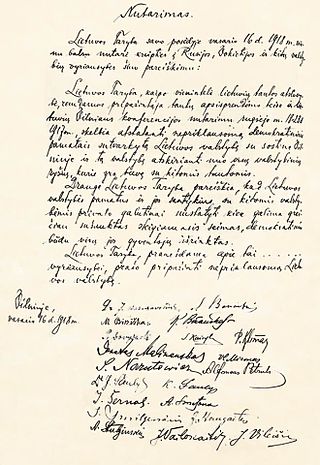
The Act of Independence of Lithuania or the Act of February 16th, also the Lithuanian Resolution on Independence, was signed by the Council of Lithuania on February 16, 1918, proclaiming the restoration of an independent State of Lithuania, governed by democratic principles, with Vilnius as its capital. The Act was signed by all twenty representatives of the Council, which was chaired by Jonas Basanavičius. The Act of February 16 was the result of a series of resolutions on the issue, including one issued by the Vilnius Conference and the Act of January 8. The path to the Act was long and complex because the German Empire exerted pressure on the Council to form an alliance. The Council had to carefully maneuver between the Germans, whose troops were present in Lithuania, and the demands of the Lithuanian people.

The 1926 Lithuanian coup d'état was a military coup d'état in Lithuania that replaced the democratically elected government with a nationalist regime led by Antanas Smetona. The coup took place on 17 December 1926 and was largely organized by the military; Smetona's role remains the subject of debate. The coup brought the Lithuanian Nationalist Union, the most conservative party at the time, to power. Previously it had been a fairly new and insignificant nationalistic party. By 1926, its membership reached about 2,000 and it had won only three seats in the parliamentary elections. The Lithuanian Christian Democratic Party, the largest party in the Seimas at the time, collaborated with the military and provided constitutional legitimacy to the coup, but accepted no major posts in the new government and withdrew in May 1927. After the military handed power over to the civilian government, it ceased playing a direct role in political life.

The Third Seimas of Lithuania was the third parliament (Seimas) democratically elected in Lithuania after it declared independence on 16 February 1918. The elections took place on 8–10 May 1926. For the first time the Lithuanian Christian Democratic Party were forced to remain in opposition. The coalition government made some unpopular decisions and was sharply criticized. Regular Seimas work was interrupted by a military coup d'état in December 1926 when the democratically elected government was replaced with the authoritarian government of Antanas Smetona and Augustinas Voldemaras. The Third Seimas was dissolved on 12 March 1927 and new elections were not called until 1936.
The Fourth Seimas of Lithuania was the fourth parliament (Seimas) elected in Lithuania after it declared independence on 16 February 1918. The elections took place on 9 and 10 June 1936, a bit less than ten years after the Third Seimas was dissolved by President Antanas Smetona. The Seimas commenced its work on 1 September 1936. Its five-year term was cut short on 1 July 1940 when Lithuania lost its independence to the Soviet Union. It was replaced by the People's Seimas in order to legitimize the occupation. Konstantinas Šakenis was the chairman of the Seimas.
Soviet–Lithuanian Non-Aggression Pact was a non-aggression pact, signed between the Soviet Union and Lithuania on September 28, 1926. The pact confirmed all basic provisions of the Soviet–Lithuanian Peace Treaty of 1920. The Soviet Union continued to recognize Vilnius and Vilnius Region to Lithuania, despite the fact that the territories were under Polish control since the Żeligowski's Mutiny in 1920. It also recognized Lithuania's interests in the Klaipėda Region. In exchange Lithuania agreed not to join any alliances directed against the Soviet Union, which meant international isolation at the time when Soviet Union was not a member of the League of Nations. Ratifications were exchanged in Kaunas on November 9, 1926, and the pact became effective on the same day. The pact was registered in League of Nations Treaty Series on March 4, 1927.
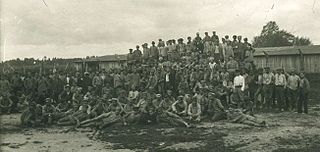
The Lithuanian–Soviet War or Lithuanian–Bolshevik War was fought between newly independent Lithuania and the Russian Socialist Federative Soviet Republic in the aftermath of World War I. It was part of the larger Soviet westward offensive of 1918–1919. The offensive followed the retreat of German troops and sought to establish Soviet republics in Ukraine, Belarus, Lithuania, Latvia, Estonia, Poland and link up with the German Revolution. By the end of December 1918 Soviet forces reached Lithuanian borders. Largely unopposed, they occupied one town after another and by the end of January 1919 controlled about two thirds of the Lithuanian territory. In February, the Soviet advance was stopped by Lithuanian and German volunteers, who prevented the Soviets from capturing Kaunas, the temporary capital of Lithuania. From April 1919, the Lithuanian war went parallel with the Polish–Soviet War. Poland had territorial claims over Lithuania, especially the Vilnius Region; these tensions spilt over into the Polish–Lithuanian War.

The Klaipėda Convention was an international agreement between Lithuania and the countries of the Conference of Ambassadors signed in Paris on May 8, 1924. According to the convention, the Klaipėda Region became an autonomous region under unconditional sovereignty of Lithuania.

The Directorate of the Klaipėda Region was the main governing institution in the Klaipėda Region from February 1920 to March 1939. It was established by local German political parties to govern the region between the signing of the Treaty of Versailles and establishment of French provision administration. Instead of replacing it, the French legitimized the Directorate. It mainly represented German interests and supported the idea of leaving the region as a free city, similar to the Free City of Danzig. Dismayed Lithuanian government and Prussian Lithuanian activists, who campaigned for incorporation into Lithuania, organized the Klaipėda Revolt in January 1923. The revolt was staged as a popular uprising against the unbearable oppression by the German Directorate. The revolt was successful and the region was incorporated into Lithuania as an autonomous region, governed by the Klaipėda Convention of May 1924.
The Lithuanian conferences during World War I refer to ten conferences held by Lithuanian activists during World War I in Switzerland and Sweden. They articulated the vision of independent Lithuanian state free of Russian, German, and Polish influence and as such were an important step towards the Act of Independence of Lithuania in February 1918.

The Lithuanian Nationalist Union, also known as the Nationalists, was the ruling political party in Lithuania during the authoritarian regime of President Antanas Smetona from 1926 to 1940. The party was established in 1924 but was not popular. It came to power as a result of the December 1926 military coup. From 1927 to 1939, the Council of Ministers included only members of the LTS. In 1936, other parties were officially disbanded, leaving LTS the only legal party in the country. At the end of the 1930s new members started bringing in new ideas, right wing and closer to Italian Fascism. The party was disestablished after the Soviet occupation of Lithuania in June 1940. A party of the same name was reestablished in 1990 and claims to be the successor of the interwar LTS.

